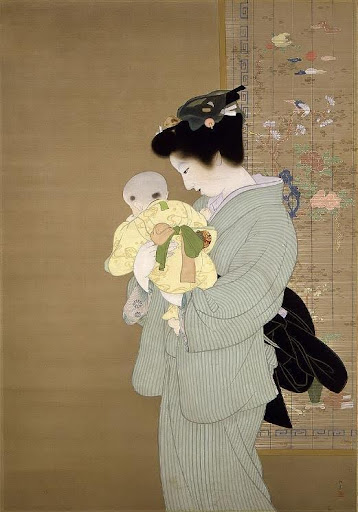14.母子
(Mother and Child)
母性表現の到達点とも言える重要文化財指定作品

《母子》は、1934年)に描いた作品。松園が母への深い敬慕と日本女性の精神的美を描いた傑作である。眉を剃り、お歯黒を施した既婚女性の姿。これは当時の既婚女性の風俗を忠実に再現したもので、松園が理想とした「清澄で卑俗なところのない美」の象徴である。母の腕に抱かれた赤ん坊は、黄色の布に包まれ、指をしゃぶる仕草を見せている。無垢な幼児の姿と、それを慈しむ母の視線が、静かな感動を呼び起こす。背景に花鳥や雷文が描かれた簾(すだれ)が垂れ下がり、季節は夏と推察される。これは松園が祇園祭で見た簾の記憶から着想を得たと語っている。この作品は、松園の母・仲子が亡くなった年に描かれたもので、母への追慕が制作の根底にある。モデルは松園の息子・松篁の妻「たね」と、その子である「敦」だとされ、三世代の母性の継承が込められている。松園は「私を生んだ母は、私の芸術までも生んでくれた」と語っており、この作品はその言葉を絵画として昇華したものである。
Mother and Child (1934)
An Important Cultural Property portraying maternal grace
Painted in 1934, Mother and Child is one of Shōen Uemura’s most profound works, expressing her deep reverence for her own mother and the spiritual beauty of Japanese womanhood. The figure, with shaved eyebrows and blackened teeth, reflects the traditional appearance of a married woman at the time—an embodiment of Uemura’s ideal of “pure, untainted beauty.”
Cradled in her arms, the infant wrapped in a yellow cloth suckles its finger, evoking a quiet emotional resonance through the mother’s tender gaze. Behind them hangs a sudare blind adorned with flower, bird, and thunder motifs, suggesting a summer setting. Uemura stated that she drew inspiration for this detail from her memory of such a blind at the Gion Matsuri.
The painting was created in the year Uemura’s mother, Nakako, passed away, and the sense of longing and tribute permeates the work. The models are believed to be Uemura’s daughter-in-law, Tane, and her child, Atsushi—representing three generations of maternal continuity.
Uemura once said, “The mother who gave birth to me also gave birth to my art.” This painting is a visual crystallization of that sentiment.
お問い合わせ
〒154-0024 東京都世田谷区三軒茶屋1-39-7